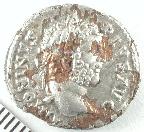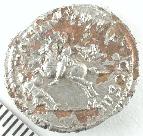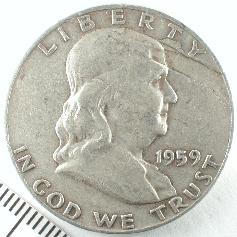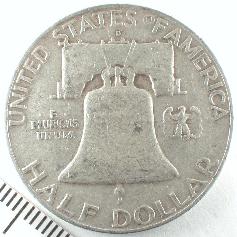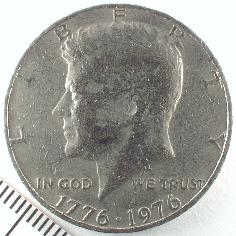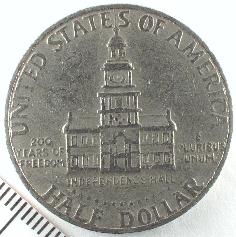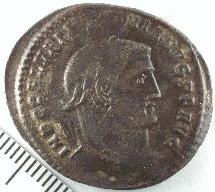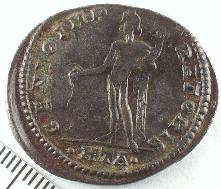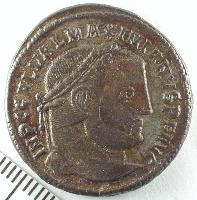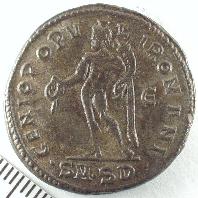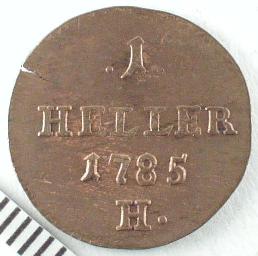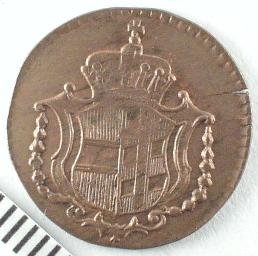Chatter
archive
also available
| Chicago Coin Club |
|---|
| Volume 49 No. 8 |
August 2003 |
|---|
Speaker's Wor[l]d
Numismatic Finds of San Martin
Presented by Don Dool to our July 9, 2003 meeting.
Before I forget to mention it, by an interesting coincidence, today, the Ninth of July, is Argentine
Independence Day.
At the August 2001 meeting, I gave a talk on San Martin as depicted in Numismatics and
Philately. Rather than repeating what I said then tonight's talk will focus on the ways in which he
has been honored using material acquired primarily on my last two trips to Argentina.
During my last trip I acquired considerable San Martin literature, books, catalogs, newspaper
articles, etc. The most useful was one of 200 copies of Burzio's Numismatica Sanmartiniana,
published in 1950 on the centenary of San Martin's death. In addition I purchased a work by
three members of CNBA, Oscar Marotta, Jorge O. Fernandez and Miguel A. Morucci, that
catalogs the medals in a private museum in Buenos Aires,
Catalogo de la Coleccion de Medalls Sanmartinians del Museo de Los Corrales Viejos.
There is also a new book by Teobaldo Catena,
Historia Numismática Sanmartinian
that I hope takes up where Burzio left off in 1950.
Of 50 of these that were printed, only 40 were released for sale; my copy is waiting for me to pick
it up in Buenos Aires.
Burzio categorizes the numismatic material into seven chapters; I. Medals awarded San Martin,
1808-1822; II. Campaign of the Andes and Liberation of Peru, 1817-1821; III. Campaign of the
Pacific and Liberation of Peru, 1820-1822; IV. Commemoratives and Homages until the
Centenary of his Birth, 1818-1878, V. Commemoratives and Homages, 1883-1948, VI.
Commemoratives of his Death, 1950. He also indexes them by twelve subject matter categories.
Obviously I have none listed in chapter one, there was one from chapter three at CICF, Burzio
79, a silver medal issued in 1821 for the soldiers who helped liberate Peru. The asking price was
$7000 so I 'll have to be content with the bronze reproduction issued in 1917.
I do have one from Chapter IV, 145a. Issued in 1878 by the Municipality of Buenos Aires on the
centenary of San Martin's birth. Burzio 144, struck in gold, silver, copper and lead, and 145,
struck in silver and copper, are the first medals issued commemorating San Martin. One of the
differences between the two medals is in the spelling of the city name, Buenos Ayres on 144 and
Buenos Aires on 145.
Chapter V has 335 pieces listed and these are obviously the most readily obtainable. Here I'll
break them down into the subject matter categories.
First, a small category, Homenajes Diversos (Diverse homages). In a subcategory, Argentino
chilenos, Burzio 301, issued on the centenary of Chilean Independence by the Military College
of Chile, this medal honors San Martin, O'Higgins and the Argentine Military College. San
Martin and O'Higgins who fought together in the War of Independence were also childhood
friends.
Another subcategory, Excursiones patrióticas - Patriotic excursions, has three medals and by
chance I acquired all three of them on this trip.
In order of issue:
Burzio158 (copper) or 158b (silver), looks silver but the weight, 24 gm. is closer to that given for
158, 24.4 gm., than for 158b, 27 gm., possibly a silver wash was added to a 158. The medal was
issued to commemorate the excursion by students to San Lorenzo. San Lorenzo is a city on the
Paran River just north of Rosario, where San Martin defeated a royalist force on February 3,
1813.
Burzio 159a. The reverse has, in addition to the Argentine arms, the arms or emblems of fourteen
provinces. There are now twenty-three provinces and the Federal Capital of Buenos Aires as
areas in the south and northeast that were territories in 1896 have been admitted to provincial
status.
Burzio 259. This medal also commemorates an excursion, this time I believe not only to San
Lorenzo but also to Chacabuco and Maipu. If this is the case it would have been quite a train ride
for this group of schoolteachers from Corrientes; it is about 2000 kilometers from Corrientes to
Chacabuco and Maipu by way of San Lorenzo as the crow flies and the trains probably took a
much longer route. I bought the medal and postcard of the monument at Corrientes at the same
time.
Next the largest category, Monuments and Statues. Monument inaugurations were a popular
theme for Argentine medalists, Burzio lists sixty-eight issued for San Martin monuments in
thirty-six different locations along with thirteen other monuments commemorating
Independence, the Army of the Andes, the Grenadier Regiment and the Argentine patriarchs. If
one counts those issued in different metals these numbers would more than double. While most
monuments to San Martin are found in Argentine and other South American cities, such as
Santiago, Lima, Bogota, Asuncion, Quito, Rio de Janeiro and Guayaquil, they are also located in
such diverse locations as New York City, Washington, D.C., Madrid, Rome, Boulogne Sue Mer
and strangely, Cairo, Egypt. Of those I have seen personally or in photos, San Martin is usually
on horseback with two of the horse's feet in the air. Interestingly the monument in Bs. As. did
not have a medal commemorating its inauguration. This monument was dedicated in 1862 and
apparently the issuance of medals had not yet come into vogue. However, in 1950 one medal was
issued commemorating a monument to San Martin and his wife, Doña María. According to
Burzio this monument was located in front of Doña María's tomb in Recoleta. Naturally I made
my way to photograph the monument and the tomb, the tomb was still there but the monument
was not. I understand that during the last several years various bronze and copper monuments
have been stolen and probably melted for their salvage value. I noticed that several plaques had
been ripped off the fountains on Ave 9 de julio and that a small statue of a boy about one half
block from my apartment has disappeared. At least I snapped photos of Doña María's tomb and
while I was in Recoleta I did the same at Eva Peron's tomb.
One of my goals on the last trip was to try to match up medals commemorating the inauguration
of San Martin monuments with corresponding postcards; this was before I bought my copy of
Burzio. I found that many of the statue postcards that I bought did not have medals to go with
them.
Monument orders in order of issuance:
185a, Yapeyu, inauguration on October 12, 1899 of the monument in San Martin's birthplace.
This statue is the only one I know of that has a bust on a column.
205, Santa Fe, a most interesting medal commemorating the inauguration of the monument in
Santa Fe, capital city of Santa Fe province. I am indebted to Fernando Iuliano for providing the
background on this medal not only in Spanish but also with an English translation. The metal
used for the metal came from a cannon that was a trophy of the War of Independence. This
cannon, named "Asopo", was fabricated by Peruvian artisans at the Rio Tinto ironworks some
time during the reign of Carlos III, 1759-1788, and was adorned with a legend in his honor. In
addition to this medal, another was coined in 1906 to commemorate the repatriation of the
remains of General Las Heras.
226, Mendoza, issued by the Museo Histórico Nacional.
245a, Esperanza, one of two commemorating the inauguration of the monument in the city of
Esperanza.
266, San Martin de Mendoza, inauguration of the monument of the statue of San Martin in a
small city named for him in the province of Mendoza. Here San Martin is depicted standing on a
pedestal, all of the other monuments I know of have him on horseback. Nineteen-ten was the
centenary of Argentine independence so there was a multitude of medals issued; this was one of
the two issued for monuments to San Martin erected in that year, the other being in San Lorenzo.
Not surprisingly, there are several places named San Martin in Argentina; for example, in
province Formosa there are two small towns near the Paraguayan border named San Martin 1
and San Martin 2.
318, San Antonio Oeste, located on the Atlantic coast at almost 41 degrees south, it is one of
eight San Antonios in Argentina. This monument was dedicated on the Argentine Independence
Day.
331a, Rosario, the horse in the statue at Rosario does have two feet in the air, not in the rearing
position but in a trot. When this position is used San Martin is almost always holding a banner in
his right hand.
344, Jujuy, San Salvador de Jujuy in the colonial northwest province of Salta. Here the horse is
in the rearing position and San Martin's right hand is well above his head. Some, such as in
Buenos Aires, have his right arm outstretched only a little above the shoulder.
358, Regimiento de Granaderos, placing of the foundation stone 12 Feb 1917.
369, Las Conchas, the attached ribbon in the colors of the Argentine flag is probably original.
......, Rio Cuarto, Burzio missed this one but it is listed in MFM, 129-1.
Another category is Commercial and Industrial. I have one example, 463, issued by a cigaret
manufacturer.
Several more contemporary medals that are in the Los Corrales Viejos collection.
MFM 178-1, issued in 1975 by the ANA.
MFM 182-2, a monstrous, silver plated beauty issued on the bicentennial of San Martin's birth.
On the reverse is the banner of the Andes with the Argentine Sun at the top, the Chilean Star to
the left and the Peruvian Sun to the right. The obverse and reverse adorn the front and back cover
of the Los Corrales Viejos catalog.
MFM 182-3, issued by the Academia de la Historia. One of seventeen medals listed in
Catalogo de La Coleccion de Medallas Sanmartinianas del Museo de Los Corrales Viejos
for the bicentenary.
One that I got in a CNBA auction. The reverse inscription translates to "2000 Year of the Father
of the Country, General Don Jose de San Martin".
One of the perks of becoming a member is being allowed to pick a copy of a CNBA publication
from the library. Carlos Graziadio suggested the issue of "Cuadernos de Numismatica y Ciencias
Historicas" (predecessor publication of CNBA's El Telégrafo)
that had an article about the facsimile medals issued by the Sociedad "La Medalla".
The first of my facsimiles is Gonzales 14, Medalla del Cabildo de Buenos Aires al Gral. San
Martin. The original, Burzio 4, issued in gold, was presented to San Martin in honor of his
victory at Chacabuco, 12 February 1817. The Museo Histórico Nacional has the original.
Twelve of the facsimiles are of cloth patches issued during the revolution. Oddly, Burzio lists
twenty-four escudo de paños (cloth patches) but La Medalla only made facsimiles of four of
these and for some reason Burzio did not include the other eight in his work. Burzio does
mention that at least eight of the originals are in Museo Histórico Nacional; next year I must take
a closer look. A photo of the museum numismatic case only shows eight of the facsimiles and I
do not recall seeing any of the cloth originals in any museum.
Gonzales 25, Escudo de Tucumán, the translation of the legend is "The motherland to its
defenders in Tucumán." While there was a battle at Tucumán in 1812, San Martin set up a
defensive position and training camp there in January 1814 before leaving for Córdoba in April
for health reasons. This patch was probably awarded at that time.
Cucha Cucha, Gonzales 26, a battle in Chile.
Gonzales 27. This was for an action that took place on 20 March 1814 at Membrillar, near
Concepción, Chile. The revolutionary forces were commanded by O'Higgins and Mackenna,
who was the hero of the day.
Gonzales 28, Tupiza, I could not find any information on this one, other than locating it on the
map, just north of the Argentine border in Alto Peru, or modern day Bolivia.
Gonzalez 29, La Florida, where this battle took place on 25 May 1814, is also in Alto Peru,
located between Santa Cruz and Cochabamba. The revolutionary general, Arenales, defeated the
royalist forces in this battle.
Gonzales 30 (original Burzio 18), Chacabuco, awarded to the troops. The battle of Chacabuco is
one of the most important of the revolution. After crossing the Andes, one of the most daring and
difficult feats in military annals, San Martin surprised the royalist forces camped on the plain of
Chacabuco. The Spanish were routed, and San Martin and O'Higgins captured Santiago.
Gonzales 32, Chacabuco, awarded to San Martin.
Gonzales 31, Escudo de Córdoba. I am unable to tie the legend, Honor a los restauradores del
Orden (Honor to the restorers of order) to any event in Córdoba. Possibly it has some reference
to a meeting in Córdoba between San Martin and Pueyrredon.
Gonzales 33 (Burzio 200). The action at the River took place on the 26th and 27th of May 1817.
Under difficult conditions a joint Argentine-Chilean force crossed the river and destroyed the
Spanish forces on the other side.
Chuchanga, Gonzales 34, is another one with no information.
Gonzales 35, Burzio 60. The battle of Chancay took place the twenty-seventh of November
1820. General Pringles attacked and defeated a superior force under the command of the Spanish
general Valez. This award was made by San Martin in his Order of the Day No. 9, 10 January
1821.
The twelfth cloth patch facsimile is from Rio Bamba and so far I have not been able to find one.
This completes the presentation of material acquired.
Works Cited:
Burzio, Humberto F., and Otamendi, Belisario J. Numismatica Sanmartiniana. Buenos Aires:
n.p. 1951.
Marotta, Oscar, Fernandez, Jorge O., and Morucci, Miguel A. Catalogo de La Coleccion de
Medallas Sanmartinianas del Museo de Los Corrales Viejos. Buenos Aires: Artes
Gráficas, 1997.
Gonzales Conde, José M. "Acuñaciones de la Sociedad `La Medalla'". Cuandernos de
Numimatica y Ciencias Historica. 20.86 (1993): 41-44.
Show and Tell
Each image has a scale in the lower-left corner,
with the tics spaced 1 mm apart.
Because the brightness and contrast were manipulated on a computer,
the coloring of a coin's image differs from the coin's actual coloring.
-
Bob Weinstein
showed some high quality contemporary counterfeits of Roman coins.
-
A limes denarius of Septimus Severus.
These generally were cast, contained no silver, and circulated locally.
They are more common now, after the recent outpouring from Eastern Europe.
-
A fouree of Caracalla; the silver foil on a bronze core
made it originally good enough to pass.
-
Another limes denarius of Severus Alexander; this one also is cast bronze and contains no silver.
-
Lyle Daly
talks to the tellers at the bank, seeing if they have any old coins or notes.
The day before the meeting, he picked up a bunch of old notes;
mostly of series 1934, 1934-A, -B, and -C.
A group of heirs had brought in $5,200, mostly in $10 notes, found in an old mattress;
Lyle figured that it would have been worth $20,000 at 4% interest in a bank from 1942.
The hoard really smelled bad - maybe that is why the tellers gave it up;
but that led to a discussion of various home remedies to remove odors from paper,
with general agreement that placing the notes in a closed container with
plain charcoal briquettes was best - but do not use charcoal with lighter fluid
or any other additives.
-
Mark Wieclaw
showed mostly pieces that came into the shop:
-
A planchet flaw on a Franklin half dollar.
-
A Kennedy Bicentennial half dollar without a reeded edge.
It is worn, but with no striations on the edge.
The general consensus was that he should "Ask Tom DeLorey."
-
A 1986 platinum piedfort from France weighing about one ounce,
featuring the Statue of Liberty.
Fifteen of these 100 franc pieces were made,
and two walked in the door.
-
A copy of the 1933 eagle, as advertised on television!
It has 33 mils of pure gold attached to a silver core, and is individually numbered.
The store buys them for $7 and sells them for $9.
-
At the recent MidAmerican Coin Expo, Jonathan Kern had a plastic bag of follis of Galerius,
priced at $15 each or pick at $18 each.
They were of all shapes, sizes, and thickness, and even different portraits,
but all had the same inscription and featured Genius on the reverse.
-
Jeff Rosinia
likes toned coins, and is working on a 20th century set of them.
He showed an 1884-O Morgan dollar with the pattern of the canvas bag appearing in the toning.
Jeff also collects coin-related promotional materials from banks,
and showed encased coins consisting of everything from a year set to an individual Morgan dollar;
then he showed some cardboard coin savers (holders).
-
Carl Wolf
took a break from his usual primitive money exhibit,
and showed a check acquired at the MidAmerican Coin Expo;
it is from the F.S. Wells Company of Jersey City,
and features its product line and some product mottoes.
The juxtaposition of the "Rough on Rats" product name, along with its "Don't Die in the House" motto,
and products such as hair tonics and skin treatments was very catchy.
They don't advertise like that anymore!
-
Don Dool
started with a 1785 1 heller from Further Austria,
then concluded with pictures complementing his earlier talk.
They were copies of paintings in various museums of "The Embrace"
which depicts the meeting of O'Higgins and San Martin;
the image also appears on notes of Chile and Argentina.
ANA Summer Seminar Trip Report
This year's ANA Summer Seminar was the largest yet, with 450 attendees -- 75 of
whom stayed for both weeks.
To honor retiring ANA Executive Director Ed Rochette,
the 2003 Summer Seminar was dedicated to him.
I took "S.S. Central America: The Treasure Speaks," taught by Bob Evans and
Mark Borckardt, while Janet took "Women in Power on Coins and in Art," taught by
Prue Fitts with a few guest lecturers.
Janet was somewhat disappointed (Prue had enough material for a semester course
on the subject and had difficulty using her laptop), but I was very satisfied with my course.
Dwight Manley shipped in several million dollars worth of Central America gold bars from his
private collection for us to pass around, and several students brought their
Central America coins for close examination also.
Bob mentioned that "about two dozen" of the Western assay bars in the Lilly Collection in
the Smithsonian are fake, and is presenting a program on this (with Fred Holabird and another
specialist) at the ANA convention; they also have an article in the August issue
of Numismatist.
After a food service problem on the first night, everything went smoothly.
Gail Baker told me that two seminarians had to be hospitalized during the first
session, but were recovering nicely; I have no report for the second session.
(This is not surprising, as you are in a desert at 6,053 feet -- my nose
bleeds there, and you get winded easily.)
There is a book sale of duplicates from the Library,
with (usually) incredible bargain prices.
The whole experience is something not to be missed!
I saw the new ANA exhibits and library for the first time.
The library is very nice, and the exhibits totally professional -- in fact,
the World War II exhibit is better, in my opinion, than the recent "Chocolate" at the Field Museum.
They are getting many more visitors now.
However, the old exhibit giving the history of coinage has been removed.
Almost no ancient or medieval coins are to be seen.
The Bass patterns are very nice, but the gold coins are hardly
worth looking at, as the collection is of minor die varieties, displayed so
that you cannot see the difference in many cases (it is on the side of the coin
away from you).
It is difficult to look at quarter eagles from a foot away
without magnification anyhow.
There is a separate type set of U.S. gold, but it
is incomplete, as some types are reserved for the variety display.
The gift shop is much larger and nicer, and did a land office business during
the Summer Seminar.
Bob Leonard
CNA Convention Trip Report
I attended the 50th Annual CNA Convention on July 18 to 20 in Windsor.
Windsor is right across the Detroit River from The Motor City. I've
attended the past eight or so CNA conventions and can draw some contrasts
with the ANA convention.
The convention was located in the Windsor Hilton in the most picturesque
bourse room imaginable!
An outside wall was floor to ceiling glass and
looked down on the beautiful Windsor Horticultural Garden and across the
Detroit River to a beautiful skyline of GM and other major corporate
buildings.
The Windsor Coin Club was the host for the first CNA held in this city.
They did a fine job of running things.
(Note, in the CNA, there are no
paid staff to plan or administer an annual convention thus the host club
is a key component.)
This club has about 50 members and sported attractive jersey club shirts.
I didn't get an attendance count but estimate there were a few hundred people there.
Fifty tables were present in the bourse and included representatives from Krause and Coin World.
The auction, conducted by North American Numismatics, was of decidedly
smaller scope then found at ANA and focused on Canadian coins, tokens and
currency.
Speakers included John & Nancy Wilson and three individuals
presenting talks on the medals of the War of 1812.
The CNA convention is an easy venue to meet most everybody attending and,
in a few years, become part of the this small numismatic family.
Philip J. Carrigan
Our 1016th Meeting
| Date: | August 13, 2003 |
| Time: | 7:00 PM |
| Location: | Downtown Chicago
Please remember the security measures at our meeting building:
give a club officer the names of all your guests prior to the meeting day;
and everyone must show their photo-ID at the security desk. |
| Featured speaker: |
Mike Metras - Early Trains on Obsolete Currency |
|
The first steam engine in the U.S. ran on Christmas Day
in 1830 in Charleston, SC.
Mike Metras will show the early development of steam engines as reflected
on obsolete currency vignettes and other period pictures.
|
Important Dates
| August |
13 |
CCC Meeting - Featured Speaker - Mike Metras on Early Trains on Obsolete Currency |
| |
| September |
10 |
CCC Meeting - Featured Speaker - Richard Hamilton on Stock Certificates from Illinois Railroads |
| |
| October |
8 |
CCC Meeting - Featured Speaker - Robert Weinstein on Indo-Sasanian Coinage |
Birthday and Year Joined
| September |
1 |
Fred K. White |
1991 |
| September |
2 |
John Wilson |
1984 |
| September |
7 |
James M. McMenamin |
1975 |
| September |
18 |
Michael M. Dolnick |
1952 |
| September |
18 |
Gregory Gajda |
1999 |
| September |
19 |
Russell F. Wajda |
2000 |
| September |
21 |
Kerry K. Wetterstrom |
1999 |
| September |
24 |
Michael A. Pesha |
1979 |
| September |
25 |
Saul Needleman |
1992 |
| September |
26 |
Dennis P. Ciechna |
1999 |
| September |
27 |
Edward Stevens |
1996 |
| September |
29 |
Gordon R. Donnell |
1999 |
Chatter Matter
All correspondence pertaining to Club matters
should be addressed to the Secretary and mailed to:
CHICAGO COIN CLUB
P.O. Box 2301
CHICAGO, IL 60690
Visit Our Web Site
http://www.ChicagoCoinClub.org/
Contacting Your Editor
| Paul R. Hybert
|
| prhybert@worldnet.att.net |
Club Officers
| Mark Wieclaw | - President |
| Robert Feiler | - First Vice President |
| Jeff Rosinia | - Second Vice President |
| |
| Directors: | Lyle Daly
Mike Metras
Steve Zitowsky
Carl Wolf |
| |
| Other positions held are: |
| Robert Weinstein | - Secretary |
| Steve Zitowsky | - Treasurer |
| Paul Hybert | - Chatter Editor |
| Phil Carrigan | - Archivist |
